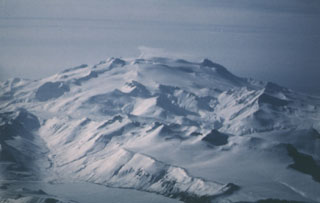Report on Makushin (United States) — June 1986
Scientific Event Alert Network Bulletin, vol. 11, no. 6 (June 1986)
Managing Editor: Lindsay McClelland.
Makushin (United States) Increased steam plume
Please cite this report as:
Global Volcanism Program, 1986. Report on Makushin (United States) (McClelland, L., ed.). Scientific Event Alert Network Bulletin, 11:6. Smithsonian Institution. https://doi.org/10.5479/si.GVP.SEAN198606-311310
Makushin
United States
53.891°N, 166.923°W; summit elev. 1800 m
All times are local (unless otherwise noted)
On 28 April at 0700, James Dickson observed a 450 m vertical steam plume over Makushin that trailed SE for at least 30 km. He detected no ash in the plume.
Geological Summary. The ice-covered Makushin volcano on northern Unalaska Island is capped by a 2.5 km caldera. Its broad, dome-like structure contrasts with the steep-sided profiles of most other Aleutian stratovolcanoes. Much of the edifice was formed during the Pleistocene, but the caldera (which formed about 8,000 years ago), Sugarloaf cone on the ENE flank, and a cluster of about a dozen explosion pits and cinder cones at Point Kadin on the WNW flank, are of Holocene age. A broad band of NE-SW-trending vents cuts across the volcano. The composite Pakushin cone, with multiple summit craters, lies 8 km SW. Table Top (Pleistocene, 68 +/- 14 ka) and Wide Bay (Holocene) cinder cones are about 20 km ENE on the peninsula across the bay from the City of Unalaska. Frequent explosive eruptions have occurred during the past 4,000 years, sometimes accompanied by pyroclastic flows and surges. Geothermal areas are found in the summit caldera and on the SE and E flanks. Small-to-moderate explosive eruptions have been recorded since 1786.
Information Contacts: J. Reeder, ADGGS.

